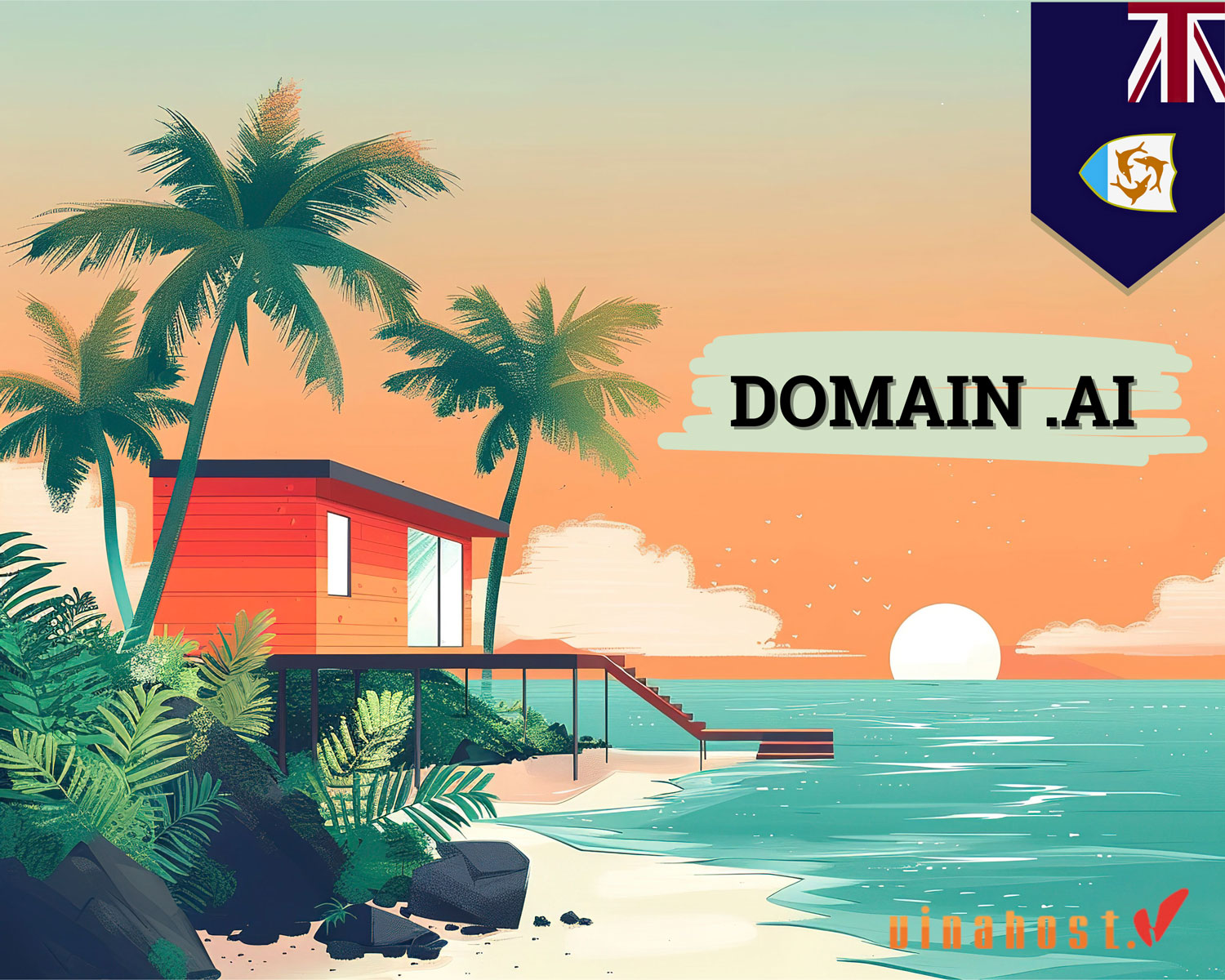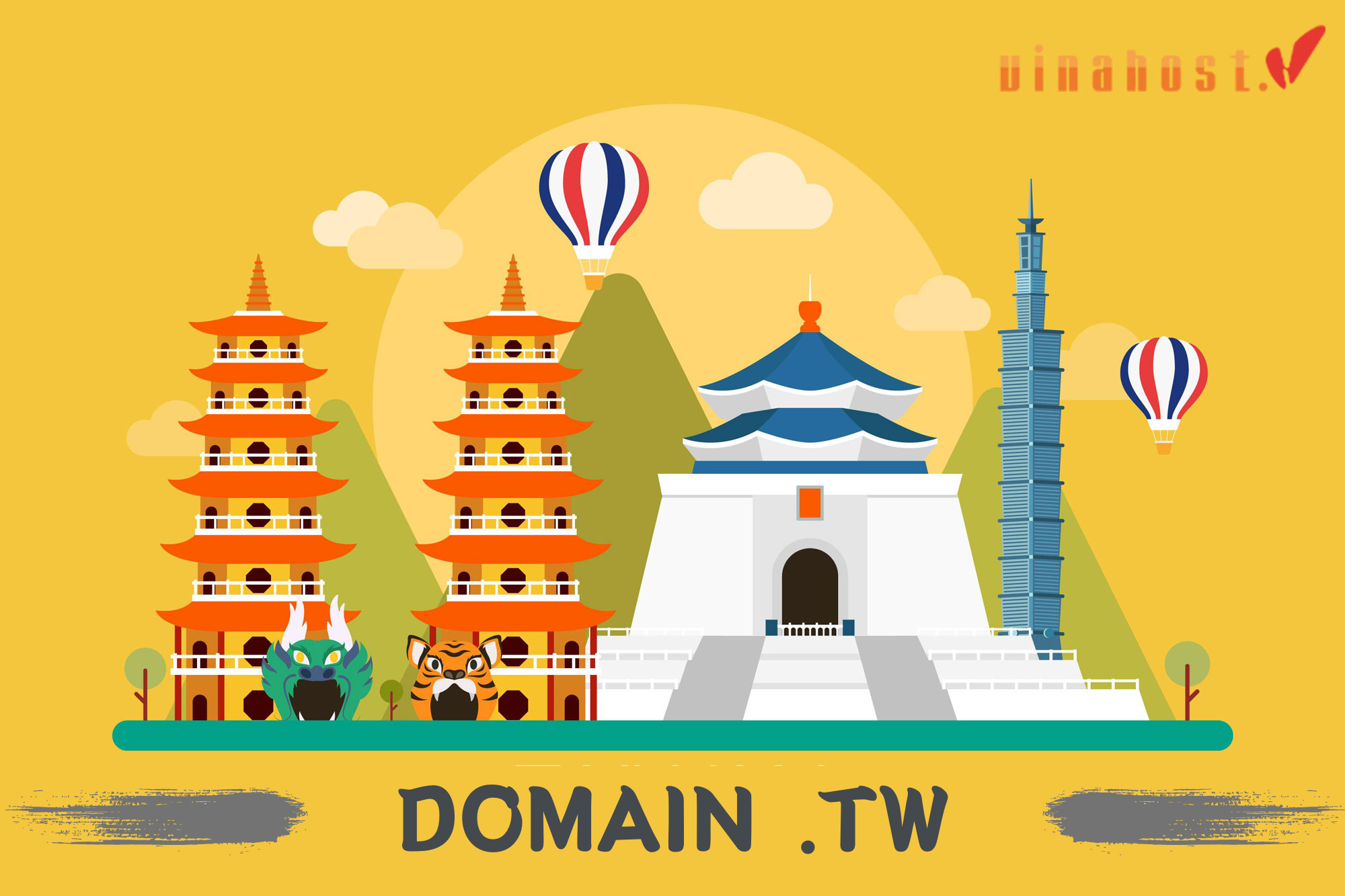What is a Domain Extension? These are extensions such as .com, .org or .net, which are added to the end of the web address and play an important role in determining the identity and purpose of the website. This VinaHost’s article will explore the importance of domain extensions, their impact on branding and SEO, and how to choose the right extension for your website’s goals and audience.
1. What is a Domain Extension?
A domain extension, also known as a top-level domain (TLD), is the extension of the domain name that comes after the last period.
Let’s start with domain name basics. Take the URL www.vinahost.vn for example. Here, the domain extension is “.vn.” If our URL is www.vinahost.net then the extension will be “.net.”
When you register a domain name through a company like ours, you can choose the extension you want. Usually, this extension reflects the purpose of the website. For example, e-commerce websites often use .com (short for “commerce”). However, nowadays, most types of websites use .com and there are many different types of domain extensions available.

Here are some common domain extensions you may come across:
- com: Originally designed for commercial businesses, but now is the most popular extension and can be used by anyone.
- biz: Created for business purposes.
- org: Originally intended for non-profit organizations, but is now universal and can be registered by anyone.
- net: Originally intended for networking organizations, but can now be used by anyone.
- gov: Limited to government organizations only.
- mobi: Usually used for mobile websites.
- us (and other country-specific domains): These are country-specific domains that typically only allow registration by entities within that country. For example, only companies headquartered in the United States can register .us domain names.
Also Read: What is Domain & How It Impacts Your Online Presence
2. A brief history of Domain Extensions
In the early 1980s, to access a website, users had to enter a long string of numbers called an IP address. Computers initially only communicated with each other through these IP addresses. This approach is ineffective and reduces the scalability of the web network. This is very different from the easy-to-use websites we have today.
Luckily, the Domain Name System (DNS) has completely changed the way we access the web. Now, we just need to enter an easy-to-remember domain name into the browser to access the desired websites. Instead of having to remember and enter complicated IP addresses, we just need to type the domain name like “google.com” or “vinahost.vn”.
When DNS was introduced, domain extensions were also established. These extensions help classify domain names into specific groups. The first six extensions are .com, .org, .net, .edu, .gov, and .mil.
Initially, there were strict regulations about which types of websites could use these extensions. Today, these regulations have become more flexible and there are now hundreds of different domain extensions. Domain extensions have simplified web access, contributing to the growth of the Internet, although they are not the only factor.
By 2008, there were only about 28 different domain extensions. However, the situation changed when the Internet Corporation for Assigned Names and Numbers (ICANN) allowed anyone with enough finances to register their own top-level domain name.
Also Read: What is ICANN? | Why Does ICANN Matter | How It Works
3. Types of Domain Extensions
3.1. Generic Top-Level Domains (gTLDs)
Generic top-level domains (gTLDs) include extensions that are not related to a specific country or region. For example, .xyz, .online and many other domains. There are many different gTLDs you can choose from for your business or personal domain.
3.2. Country Code Top-Level Domains (ccTLDs)
Country code top-level domains (ccTLDs) include domain extensions that are specific to each country or region. For example, .ca for Canada and .jp for Japan. You may encounter these ccTLDs while browsing the web, they indicate the geographical origin of the website.
3.3. Sponsored Top-Level Domains (sTLDs)
Sponsored top-level domains (sTLDs) are reserved for specific communities or industries and are not available to everyone to register. For example, .gov is for US government agencies and .edu is for educational institutions.
These domains have specific eligibility requirements and should only be used by entities that meet these standards.
3.4. New gTLDs
New generic top-level domains (gTLDs) include domain extensions introduced outside of traditional domain extensions such as .com, .net, and .org. These new gTLDs were launched as part of a program initiated by ICANN (Internet Corporation for Assigned Names and Numbers) to increase competition and diversity of choice in the domain name space. Here are some examples of New gTLDs (generic top-level domains):
- Industry-Specific: .tech, .law, .shop, .music
- Geographic: .nyc, .london, .berlin
- Generic Terms: .online, .club, .site
- Brand-Specific: .google, .apple, .bmw
- Community-Specific: .art, .eco, .gay

Also Read: What is VN domain? | Overview of domain names .VN
4. How to Choose a Domain Extension
To choose the right domain extension, you need to consider several important factors to ensure it fits your website’s goals and audience. Here are the factors to consider:
4.1. Consider Your Website’s Purpose
First, think about the main purpose of the website. Do you promote your business, share your personal interests, or build an online portfolio? Domain extensions should match your main content and purpose.
4.2. Target Audience and Location
Identify target audience and their geographical location. If your site is aimed at local users, extensions like .us or .uk may be more appropriate. For a global audience, generic extensions such as .com or .net are often preferred.
4.3. Brand Recognition and Memorability
Choose an extension that enhances brand recognition and is easy to remember. An easy-to-remember domain name will help users easily find and revisit your website. Avoid complex extensions that can be confusing for users.
4.4. SEO Implications
Although domain extensions do not directly affect SEO, relevant and trustworthy extensions can help improve website rankings on search engines. Generic extensions like .com are often considered authoritative and beneficial for SEO.
By carefully considering these factors, you can choose the right domain extension to effectively represent your website and support its online success.
Also Read: What is Domain Privacy? | Do you need Domain Privacy?
5. How much Domain Extensions Cost?
When starting a website, understanding the cost of a domain name is important. The price of the domain name depends on the primary domain name and the extension you choose.
The “.com” extension is the most popular option and also the most expensive. Due to its widespread popularity, the price of “.com” is typically about 20% higher than other popular extensions such as “.net”. This trend is still maintained because “.com” holds a large share of the domain name market.
6. The Future of Domain Extensions
The future of domain extensions is evolving with innovations that enhance online presence and user experience. Here are the main trends emerging:
- Specialized and Relevant Extensions: There are more domain extensions that are specific to specific industries, interests, and communities. This helps the brand enhance its growth and connect more closely with target customers.
- Personalized Brand Extensions: Large brands are increasingly choosing their own branded extensions (e.g. .google, .apple) to reinforce their identity brand and create a distinctive online destination.
- Geography and locality extensions: The rise of country code extensions (ccTLDs) and city-specific extensions (e.g. .nyc, .london) to promote local identity and increase online presence.
- New technology and applications: Technology such as blockchain is being used to develop decentralized domain name systems, improve security and manage ownership.
- Regulatory Expansion and Change: Continued expansion of the domain name space with new generic top-level extensions (gTLDs), which reflect shifts in regulation and demand about the diversity and meaning of domain names.
- Integration with other online services: Domain extensions are increasingly integrated with e-commerce and social media platforms, helping to accelerate branding and user interactions are more effective on these platforms.
These trends demonstrate the diversity and growth potential of domain extensions, and highlight the important role innovation and customization play in building online spaces.
Also Read: What is a Domain Registrar? | Function of a Domain Registrar
7. FAQs
7.1. Can I have multiple domain extensions for my website?
Of course, you can use multiple domain extensions to point to your website. This procedure is often called domain aliasing or domain forwarding. Here’s how it works:
- Primary domain: You choose a domain extension (for example: example.com) as your primary domain. This is the address visitors use to access your website.
- Subdomains: You purchase or register other domain extensions (e.g. example.net, example.org) that you want to point to your main domain.
- Domain forwarding: You set up domain forwarding or domain aliasing through your domain registrar or web hosting provider. This process includes configuring subdomains to redirect traffic to your main domain.
- SEO Considerations: To ensure SEO integrity and avoid duplicate content issues, you need to set up appropriate redirects (301 redirects) from subdomains to the main domain your. This helps search engines understand that all your domain name variations link to a single source.
- Brand Protection: By registering multiple domain extensions, you help protect your online brand identity, preventing competitors or illegals from using your domain names similarly.
Efficiently managing multiple domain extensions helps you expand your online presence, strengthen your brand, and ensure visitors easily find and access your site regardless of their extension usage.

7.2. Can I change my domain extension later?
Yes, you can change your domain extension, but the process involves some specific steps to do it effectively:
Register a new domain name
Choose and register a new domain name with the extension you want to use. Make sure this domain name is available for registration.
Prepare for the moving process
- Backup all data and current website.
- Notify users or customers about upcoming domain name changes.
Set up a new domain name
- Configure DNS to specify a new domain name pointing to your server or web hosting provider.
- Reinstall email accounts and other services related to the new domain name.
Traffic redirects
Set up redirects from the old domain to the new domain to ensure that people using old links or bookmarks can still access the new site.
Updated links and references
- Update internal links on the site to point to the new domain.
- Update external links or references to avoid pointing to old domains.
Notify search engines
Update your site’s URL in tools like Google Search Console to announce the domain name change.
Monitoring and testing
Monitor the migration process to ensure everything is working properly on the new domain, including testing functions and links.
Consider canceling the old domain
Once the transfer is complete and you’re sure everything works on the new domain, you can consider canceling the old domain registration.
Changing domain extensions requires careful planning and execution to minimize disruption to the website and visitors. Be sure to evaluate the SEO, user experience, and brand impact of making these changes.
7.3. What if My Ideal Domain Name is Already Taken with a Different Extension?
To get your ideal domain name with the desired extension, you have several options to consider:
- Domain Name Modifications: You can try using slight variations or modifications to an existing domain name to test availability with the extension you want. For example, add hyphens, use a different word order, or choose a different TLD (top-level domain).
- Contact the current owner: If the domain name you want already has an owner, you can contact them to ask if they are willing to sell. Be prepared for negotiation and costs can be high, especially if this is an exceptionally valuable domain name.
- Explore other extensions: In addition to your preferred extension, consider alternative extensions like .net, .org, .co, etc. You can still fit your brand or purpose. Consider the availability and relevance of these options to your site.
- Use a domain name broker service: Domain name brokers can help you buy back a domain name from the current owner. They can assist in the negotiation process and facilitate the sale.
- Availability Monitoring: Occasionally, a domain name may become available when its registration expires. You can track the status of this domain name through your registrar’s tools or a third-party service.
- Choose a new domain name: If getting your ideal domain name with the desired extension becomes difficult or expensive, consider choosing a completely new domain name that still reflects your brand and your goals.
It’s important to choose a domain name and extension that best represents your website and brand. Consider usability, SEO factors, and long-term branding strategies during this process.
Also Read: What is Domain Backorder? | Everything you need to know
8. Conclusion
So what is a domain extension? Domain extensions play an important role as an identifying factor on the vast Internet. It not only determines the nature and purpose of a website, but also influences how users and search engines perceive and display that website. Choosing the right domain extension involves considering your brand, target audience, and SEO optimization.
Understanding the importance of these factors and choosing them strategically, website owners can effectively enhance their online presence and create more meaningful connections with their target audience. Find out more articles at our Blog and don’t hesitate to contact us for support:
- Email: support@vinahost.vn
- Hotline: 1900 6046
- Livechat: https://livechat.vinahost.vn/chat.php
What is Registry Lock? | Protect Domain with Registry Lock
What is a root domain? | Why does a root domain matter?




















